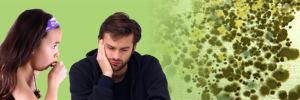Mold is not poisonous or toxic in itself, but it produces a substance known as mycotoxins, hence the term “toxic mold.” The element generally irritates, and when touched or inhale, it results in a more severe allergic reaction in the sensitive individual. Nevertheless, the presence of mold and the conditions under which it produces toxins is poorly understood. It doesn’t always mean that a mold that is capable of producing toxins produces these harmful products or poses health risks. In other cases, the mold may not cause any health problems, allergies, or any other symptoms.
Mold Reactions
The greatest health risk related to mold is an allergic reaction, which develops immediately or shortly after being exposed. Both mold spores and growing mold have the potential to trigger an allergic reaction in adults and children who are sensitive to mold.
Signs and symptoms of mold allergies include:
• Runny nose
• Sneezing
• Coughing
• Wheezing
• Watery eyes
• Itchy eyes
• Redness of the eyes
• Skin irritation or rash
What is the treatment for mold exposure?
Doctors treat an allergic reaction to mold the same as any other allergies. Indeed, a fungal infection that spreads throughout the body in people with weakened immune systems is treated in hospitals with special antifungal drugs in conjunction with other measures to enhance breathing and circulation. Besides, a physician may prescribe treatment of underlying condition like asthma depending on the severity, type of symptoms you’re experiencing.
Is it possible to prevent mold in your household?
Although it’s impossible to eliminate mold spores in your indoor environment, they do not grow in the absence of moisture. Thus, you need to control moisture by taking an effective measure such as:
• Adding mold inhibitor products to your household paints
• Adding insulation to reduce chances of condensation on cold surfaces like windows, piping, roof, and floors
• Using an air dehumidifier during humid seasons to reduce moisture content in your home.
Check out the top Dehumidifiers with a pump at Good Air Geeks for the best deals and more information on the same.
• Refraining from placing a carpet in humid basements and bathrooms
• Cleaning and drying areas after water damage and leakages in your home within 24-48 hours to prevent mold buildup
• Employing measure that will keep indoor humidity levels low (preferably between 30%-50%)
• Maintaining proper ventilation and using fans in your home will improve indoor air quality and prevent or control dampness.
• Opening bathroom windows and using bathroom fans when showering to increase air circulation
• When possible, try to vent appliances that produce moisture, including clothes dryers and stoves to the outdoors
• Identifying and repairing water leakage in the plumbing system or other structures that may lead to moisture buildup
Bottom Line
Although in small incidents you may remove mold by the use of detergent and water, dire cases require the services of a professional contractor who is trained in mold remediation and removal. They have the skills to use stronger commercial cleaners or a dilute solution of chlorine bleach to kill and remove the mold effectively. However, discuss it with your health care before attempting to remove and clean mold if you suffer from any health problem or are sensitive to molds. After mold removal, keep the affected areas dry to prevent further growth and other mold health related issues.








